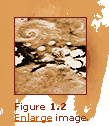|
Although Martian atmosphere is thin relative to the Earth, it
is dense enough to share many of the same dynamic features observed
within Earth's atmosphere, such as clouds and cyclones. Note the
bright white cloud formation in the middle of the image to the right
(Figure 1.2). On Earth, clouds represent the condensation of water
vapor in air. On Mars, however, clouds can be the condensation of
either water vapor or, more often, carbon dioxide vapor. Above the
polar regions, clouds are assumed to be mostly carbon dioxide clouds.
In latitudes closer to the equator, clouds are possibly water vapor
clouds because of the higher temperature. In this image(Figure 1.2),
also note the large vortex at the upper left corner. This is a Martian
cyclone, equivalent to a hurricane on Earth. This cyclone is about
250 km across.
|
 |
 |



